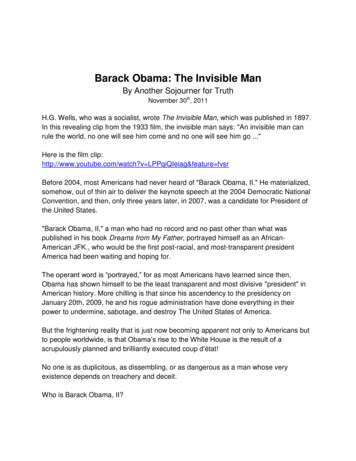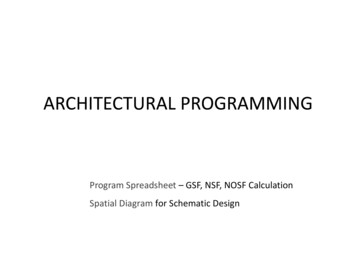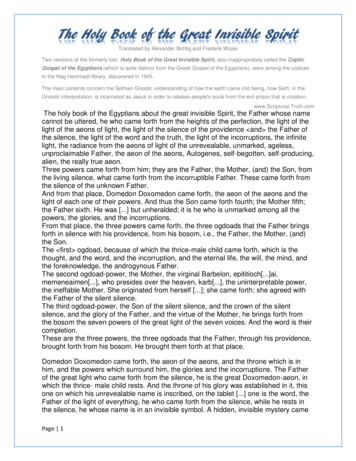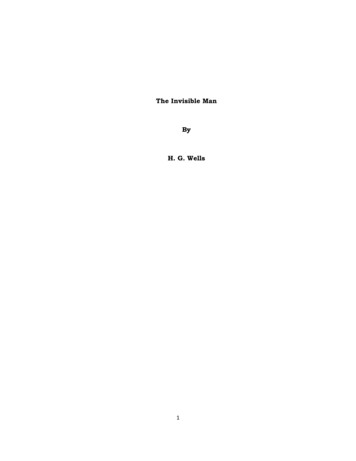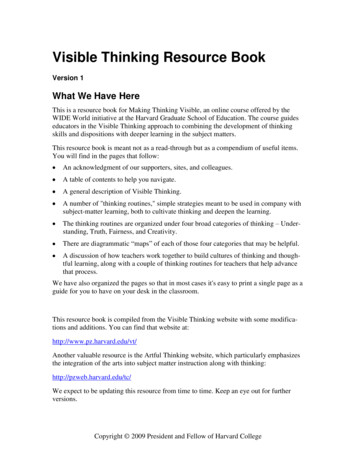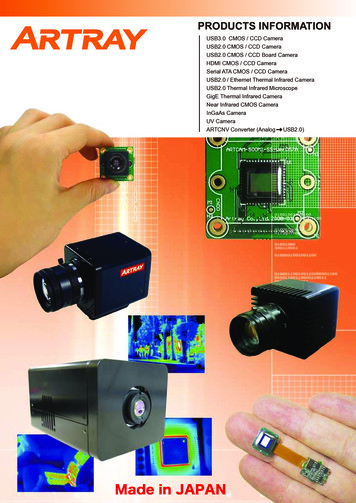
Transcription
W H E R ED I SCOV E R I E SB EG I NMAKING VISIBLE THE INVISIBLEBOLD LEADERSHIP ACTIONSCommittee on Equal Opportunities in Science and Engineering2019-2020 Biennial Report to Congress
CEOSE MISSION & BACKGROUNDThe Committee on Equal Opportunities in Science and Engineering (CEOSE) advises the U.S. NationalScience Foundation (NSF) on policies, programs, practices and activities to encourage full participationof women, underrepresented racial/ethnic populations and persons with disabilities within all levels of thenation’s STEM enterprise.The committee was established by the United States Congress through the “Science and EngineeringEqual Opportunities Act” in 1980 to address the problems of growth and diversity in America’s STEMworkforce. The legislation states the following:“There is established within the National Science Foundation a Committee on EqualOpportunities in Science and Engineering (hereinafter referred to as the “Committee”). TheCommittee shall provide advice to the Foundation concerning (1) the implementation ofthe provisions of sections 1885 and 1885d of this title and (2) other policies and activitiesof the Foundation to encourage full participation of women, minorities, and persons withdisabilities in scientific, engineering, and professional fields [42 U.S.C.§1885(c)].Every two years, the Committee shall prepare and transmit to the Director (of the Foundation)a report on its activities during the previous two years and proposed activities for the nexttwo years. The Director shall transmit to Congress the report, unaltered, together with suchcomments as the Director deems appropriate [42U.S.C. §1885(e)].”Committee members, comprising of approximately 16 individuals, come from diverse STEM disciplines,drawn from diverse institutions in higher education, industry, government and nonprofit sectors.Its membership also reflects the racial, ethnic and gender diversity of the country’s citizenry andincludes persons with disabilities. Members of the committee typically serve a three-year term. A fullcommittee meeting is held three times a year (usually winter, spring and fall) to review and evaluatepolicies and program opportunities focused on the state of participation and advancement of women,underrepresented racial and ethnic groups, and persons with disabilities in education, training andscience and engineering research. Based on the findings, the committee makes recommendations to theFoundation for improving the levels of participation of underrepresented groups in STEM professions.The committee members also interact with other federal agencies, such as the U.S. Department ofAgriculture, National Institutes of Health, the Smithsonian Institution and the White House Initiative onHistorically Black Colleges and Universities in forging ongoing collaborative insights about efforts tobroaden participation by underrepresented groups in the nation’s STEM workforce.MAKING VISIBLE THE INVISIBLEBOLD LEADERSHIP ACTIONS2
ACKNOWLEDGMENTSMembers of CEOSE are indebted to the following NSF senior officials and program staff for their technicalconsultation, collection of critical data and assistance with review and comments that enabled the completionof this Biennial Report to Congress:NSF SENIOR LEADERSHIPDR. SETHURAMAN PANCHANATHANNSF DirectorDR. KELVIN K. DROEGEMEIERFormer NSF Acting DirectorDR. FRANCE CÓRDOVAFormer NSF DirectorDR. FLEMING F. CRIMFormer NSF Chief Operating OfficerDR. KAREN MARRONGELLEChief Operating OfficerDIRECTORATE FOR EDUCATION ANDHUMAN RESOURCES (EHR)DR. SYLVIA (JAMES) BUTTERFIELDActing Assistant DirectorDR. JERMELINA TUPASDeputy Division DirectorMS. MARTHA JAMESAssistant Program DirectorDR. TORI SMITHProgram Lead, NSF INCLUDESDR. MONYA RUFFIN-NASHFormer Program Lead, NSF INCLUDESOFFICE OF INTEGRATIVE ACTIVITIES (OIA)DR. SUZANNE IACONOCEOSE Executive Liaison and Office HeadDR. CLEMENCIA COSENTINOSection Head/Evaluation and AssessmentCapabilityDIRECTORATE FOR ENGINEERING (ENG)DR. DAWN TILBURYFormer Assistant DirectorDR. DON MILLARDDeputy Division DirectorDR. STEVE MEACHAMSection Head/Integrative ActivitiesDR. LORETTA MOORESection Head/Established Program to StimulateCompetitive Research (EPSCoR)DIRECTORATE FOR GEOSCIENCES (GEO)DR. WILLIAM EASTERLINGFormer Assistant DirectorDR. DRAGANA BRAZAKOVICSenior Staff AssociateDR. CHRISTINA FREYMANEvaluatorMR. TOM JONESStaff Associate for BudgetDIRECTORATE FOR MATHEMATICALAND PHYSICAL SCIENCES (MPS)DR. SEAN JONESAssistant DirectorDR. RANDY PHELPSStaff AssociateDR. ERIKA J. RISSISenior Staff AssociateDR. TIM VANREKENProgram Director3
OFFICE OF EQUITYAND CIVIL RIGHTS (OECR)MS. RHONDA DAVISOffice HeadMR. JAVIER INCLANDeputy Office HeadMS. ZITA R. BARNETTExpertMS. SABRINA CARAWAYDiversity and Inclusion Program ManagerMR. SHAWN MURRAYData AnalystDIRECTORATE FORBIOLOGICAL SCIENCES (BIO)DR. JOANNE TORNOWAssistant DirectorDR. ALAN TESSIERDeputy Assistant DirectorDR. PATRICIA SORANNODivision DirectorDR. KAREN CONESenior AdvisorDR. ROLAND ROBERTSSenior AdvisorDR. DOUGLAS LEVEYProgram DirectorDIRECTORATE FOR COMPUTERAND INFORMATION SCIENCE ANDENGINEERING (CISE)DR. MARGARET MARTONOSIAssistant DirectorDR. JOYDIP KUNDUActing Deputy Assistant DirectorDR. ERWIN GIANCHANDANIFormer Deputy Assistant Director4DIRECTORATE FOR SOCIAL, BEHAVIORALAND ECONOMIC SCIENCES (SBE)INCLUDING NATIONAL CENTER FORSCIENCE AND ENGINEERING STATISTICS(NCSES)DR. KELLINA CRAIG-HENDERSONDeputy Assistant DirectorMS. EMILDA RIVERSDivision DirectorDR. MAY AYDINProgram DirectorDR. JOHN FINAMOREProgram DirectorDR. KAREN HAMRICKSenior Analyst
We are grateful for the informative presentations and compelling perspectives of invited speakers,including Ellen Ochoa, NSB Chair; Victor R. McCrary, NSB Vice Chair; Roger N. Beachy, NSB member/Chair of “The Vision 2030 Task Force”; Kimberly Rause, former evaluator at 2M Research; Ray McGhee,former senior leader of NSF INCLUDES Coordination Hub; Leigh M. Jackson, study director and seniorprogram officer at The National Academies of Science, Engineering and Medicine; and NSF PIs/CoPIs Kalynda C. Smith of Hampton University; Carmen M. Lilley of University of Illinois at Chicago;Susan Renoe of University of Missouri; Sheryl Burgstahler of University of Washington; Anne Gatesof University of Texas at El Paso; Bruce DeRuntz of Southern Illinois University Carbondale; RobertKirsch of Arizona State University; and Rebecca Batchelor of University of Colorado Boulder. A specialthank you is also extended to the BIO advisory committee for having a very engaging joint sessionwith CEOSE under the leadership of Carla Caceres of University of Illinois at Urbana-Champaign.We are appreciative of the presentations and briefings by representatives from other federal agenciesincluding Jonathan Holifield, Executive Director of the White House Initiative on Historically BlackColleges and Universities; David Wilson, Director, and Juliana Blome, Assistant Director, Tribal HealthResearch Office at NIH; and the CEOSE federal liaisons Lisa Evans of NIH and Shahin Nemazee ofSmithsonian Institution.Deep appreciation to NSF’s Office of Integrative Activities staff members for coordination efforts:Jolaina Jeff-Cartier, staff associate; Una Alford, program analyst; Stephanie Hill, program analyst;and John Paul White, IT specialist. Special thanks to Bernice T. Anderson, CEOSE executive secretaryand senior advisor for technical contributions and oversight and Steven Buhneing, communicationspecialist for report preparation and communications support.Lastly, we would like to thank Guardians of Honors for their help with references, appendices andother report matters; Nicole Fuller and Trinka Kensill (Sayo-Art LLC) for creating the collage ofimages on the front cover; Christina Bartlett-Whitcomb (OD/OLPA) for copy editing services; and theDesign and Publishing Section of the Information Dissemination Branch (OIRM/DAS) for designingthe report.5
TABLE OF CONTENTSACRONYMS. 7EXECUTIVE SUMMARY. 9I.INTRODUCTION:MAKING VISIBLE THE INVISIBLE.12II. BROADENING PARTICIPATION IN AMERICA’S SCIENTIFIC ENTERPRISE:INSIGHTS, CHALLENGES/OPPORTUNITIES AND IMPLICATIONS.13III. NSF’S BROADENING PARTICIPATION DATA AND ACCOMPLISHMENTS:BP PORTFOLIO, PROGRAMS, PROJECTS, POLICIESAND PRACTICES, AND PRIORITIES. 20IV. CEOSE ACTIVITIES IN 2019-2020 AND PLANS FOR 2021-2022. 30V. CEOSE RECOMMENDATION: MAKING VISIBLE THE INVISIBLE. 4 1.REFERENCES.48APPENDICES. 49Appendix A: National Science Foundation Programs to Broaden Participation 2021Budget Request to CongressAppendix B: National Science Foundation Report on FY 2019 Funding toMinority-Serving InstitutionsAppendix C: elected Merit Review Tables from the Merit Review Process:SFiscal Year 2019 DigestAppendix D:NSF Scientists and Engineers, FY11-FY20Appendix E:NSF’s HBCU Agency PlanAppendix F:2017-2018 CEOSE DCL and Report HandoutAppendix G: Examples of NSF-Supported Programs, Projects, Strategies/Activities, and EventsRelated to CEOSE’s Recommendation of Investing in Diverse Community VoicesAcross the Research and Education Portfolios through Community-Driven ProjectsCEOSE MEMBERSHIP 2019-2020.676
ACRONYMSAccessINCLUDES. Linking the knowledge andresults of NSF disability-relatedprojects and projects withinthe NSF INCLUDES NationalNetworkAIE-STEM. Access to Innovative Education:STEM Opportunities for Studentswith Learning DisabilitiesADVANCE. Organizational Change forGender Equity in STEMAcademic ProfessionsAI. Artificial IntelligenceARIS. Center for Advancing ResearchImpact in SocietyASPIRE Alliance. The National Alliance for Inclusiveand Diverse STEM FacultyATC. Advanced Technology CenterDIVE. Diversity and Inclusion VideoExhibitionDO-IT. Disabilities, Opportunities,Internetworking, and TechnologyCenterEAGER. Early-Concept Grant forExploratory ResearchEDSIN. Environmental Data ScienceInclusion NetworkEHR. Directorate for Education andHuman ResourcesENG. Directorate for EngineeringEPSCoR. Established Program toStimulate Competitive ResearchFASED. Facilitation Awards for Scientistsand Engineers with DisabilitiesBI. Broader ImpactsGEO. Directorate for GeosciencesBIIS. Budget Internet InformationGEO GOLD. Geoscience Opportunities forSystemBIO. Directorate for Biological SciencesBP. Broadening ParticipationBPCnet. Broadening Participation inComputing Resource PortalCEOSE. Committee on Equal Opportunitiesin Science and EngineeringCISE. Directorate for Computerand Information Science andEngineeringCOVID-19. Coronavirus Disease of 2019CREST. Centers of Research Excellencein Science and TechnologyDCL. Dear Colleague LetterLeadership in DiversityGPRA. Government Performance andResults Modernization ActHAAEs. High African AmericanEnrollmentHAIEs. High American Indian EnrollmentHBCU. Historically Black Colleges andUniversitiesHBCU-EiR. Historically Black Colleges andUniversities — Excellence inResearch programHBCU-UP. Historically Black Colleges andUniversities — UndergraduateProgramHHE. High Hispanic Enrollment7
HSI. Hispanic-Serving InstitutionIHE. Institutions of Higher EducationIPA. Intergovernmental Personnel ActIT. Information TechnologyIUSE GEOPaths. Improving UndergraduateSTEM Education: Pathways intoGeoscienceJCORE. White House National Scienceand Technology Council’s JointCommittee on the ResearchEnvironmentLDP. Leadership DevelopmentProgramLTER. Long-Term Ecological ResearchNetworkMR. Merit ReviewMRI. Major Research InstrumentationMSI. Minority-Serving InstitutionNASA. National Aeronautics and SpaceAdministrationNASEM. National Academies of Sciences,Engineering and MedicineNCSES. National Center for Science andEngineering StatisticsNEON. National Ecological ObservatoryNetworkNIH. National Institutes of HealthNSB. National Science BoardNSF. National Science FoundationNSF INCLUDES. Inclusion across the Nation ofCommunities of Learners ofUnderrepresented Discoverers inEngineering and ScienceOIA. Office of Integrative Activities8OLPA. Office of Legislative and PublicAffairsOSTP. [White House] Office of Scienceand Technology PolicyPAESMEM. Presidential Awards forExcellence in Science,Mathematics, and EngineeringMentoringPIs. Principal InvestigatorsRAPID. Rapid Response Research GrantREU. Research Experiences forUndergraduatesRII. Research InfrastructureImprovementS&E. Science and EngineeringSBE. Directorate for Social, Behavioraland Economic SciencesSEAPD-STEM. Southeast Alliance for Personswith Disabilities in STEMSTCs. Science and Technology CentersSTEM. Science, Technology,Engineering, and MathematicsTCUs. Tribal Colleges and UniversitiesTCUP. Tribal Colleges and UniversitiesProgramURG. Underrepresented GroupsVSEES. Visiting Scientists, Engineers,and EducatorsWaYS. Wabanaki Youth ScienceProgramWHI-HBCU. White House Initiative onHistorically Black Colleges andUniversitiesWMPD Report. Women, Minorities, and Personswith Disabilities in S&E Report
EXECUTIVESUMMARY9
EXECUTIVE SUMMARYDiverse perspectives are necessary for solving critical scientific and social challenges such as disease,hunger, poverty, safety and security. Yet, statistics show relatively little diversity in the fields of science,technology, engineering and mathematics necessary to solve those issues. As the nation’s population ofunderrepresented and underserved groups grows, the inclusiveness of people from diverse backgroundsis foundational to the success of the nation’s science and engineering enterprise. STEM leaders fromunderrepresented groups, including Black or African American, Hispanic or Latino American, AmericanIndian or Alaska Native, persons with disabilities and women, provide the different cultural perspectivesnecessary to solve the broad spectrum of human problems. In its last report to Congress, the Committee onEqual Opportunities in Science and Engineering (CEOSE) suggested the U.S. National Science Foundation(NSF) provide “increased support for place-based implementation research projects that are groundedin and engage local communities.” Expanding research knowledge and providing the capabilities neededin underrepresented and underserved communities are absolutely necessary to foster an inclusive anddiverse network of research leaders, now and in the future.INVESTING IN BROADENING PARTICIPATIONNSF champions programs that broaden participation of groups historically underrepresented in STEM.The Foundation works to advance diversity and inclusion through its broadening participation portfolio, avariety of strategic partnerships and investments across NSF that integrate research with education, expandand modernize research infrastructure, and scale successful approaches in broadening participation. Forexample, the Inclusion across the Nation of Communities of Learners of Underrepresented Discoverersin Engineering and Science (NSF INCLUDES) program expands education pathways into the STEMcommunity through a national network of public and private partnerships designed to scale diversityefforts in STEM. Another example is the Louis Stokes Alliances for Minority Participation program, whosealliance-based initiative is designed to increase the number of STEM graduates from underrepresentedcommunities and help them transition successfully into the STEM workforce. Also, the EstablishedProgram to Stimulate Competitive Research (EPSCoR) invests in S&E research and capacity building inU.S. states and territories that receive a disproportionately low share of NSF funding. The HistoricallyBlack Colleges and Universities — Excellence in Research (HBCU-EiR) program builds on NSF’s continuingefforts to strengthen research capacity at HBCUs and expand opportunities for HBCU researchers. Theprogram supports research projects across all scientific disciplines, including education. In the areas ofsocial, behavioral, and economic science research, the Build and Broaden program encourages researchcollaborations between scholars at minority-serving institutions (MSIs) and scholars in other institutionsor organizations to help build the STEM workforce.NSF is commended for its demonstrated commitment in working toward the full inclusion of persons fromunderrepresented racial/ethnic groups, persons with disabilities, and women in STEM education, STEMresearch and the STEM workforce. As such, the following actions and implemented policies and practicesrepresent substantial progress in NSF’s leadership in the inclusion of all Americans in the S&E enterprise:NSF funding of MSIs, publicly available diversity data about NSF funding of individual investigators, andthe implementation of relevant NSF broadening participation-related policies, practices and priorities(e.g., sexual harassment terms and conditions, rapid response to COVID-19 and support to individuals andinstitutions disproportionally impacted by the pandemic, and promoting diversity among scientists andengineers at NSF).10
Today’s focus on inclusiveness is about the intellectual opportunities to address systemic issues of “ism”and biases and to remove barriers related to being overlooked, undercounted or simply missing. Morespecifically, CEOSE is calling attention to the need for more diverse scientific leadership, more attentionto the economic advantage of belongingness in STEM, and increased attention on the removal of socialand cultural barriers. Additionally, CEOSE is encouraging the development of innovative strategies andapproaches to define, monitor and report success in broadening participation, thereby addressing thechallenges related to the limits of analysis due to data quality and sample size.CEOSE ACTIVITIESSix CEOSE meetings were convened between February 2019 and October 2020 focusing on areas suchas investing in community-based research, intersectionality and STEM diversity, investing in diversecommunity voices, and understanding the STEM capacity and contributions of MSIs within the context ofadverse impacts of COVID-19. Targeted attention was placed on advancing diverse leadership in STEM,and a CEOSE leadership roundtable discussion was held. A panel was also convened that focused onmoving the spotlight from leadership development to leadership at the top.CEOSE held discussions with NSF’s Director, Chief Operating Officer, Assistant Directors, DeputyAssistant Directors, liaisons from other federal agencies, and outside experts with expertise indiversity and inclusion. Additionally, CEOSE sets as goals the inclusion of new voices, perspectives andexperiences in all its meeting discussions as well as the construction of collaborative partnerships withother organizational units, such as the National Center for Science and Engineering Statistics and theNational Science Board (NSB).CEOSE RECOMMENDATION AND SUGGESTIONSAt a fundamental level, leadership includes behaviors that guide, influence and mobilize others towarda common vision, goal or objective. In this report, we want to emphasize leadership as it takes place indecision-making, relationship-building and networking; the development of individuals as leaders; and thewillingness of all people to make the right decisions, serve as models and examples, accept responsibilityand be held accountable.Leadership is demonstrated through decisions, actions and opportunities at the organization and individuallevels. Yet, some of these actions may not be recognized as leadership. Leadership matters because leadersshape funding decisions, admit students to STEM graduate programs, decide when or if communities areinvited to partner in NSF-funded projects, and determine if the microculture of their research teams isinclusive. In demonstrating empowered leadership within the staff, advisors and communities it serves,NSF can do more to increase knowledge and awareness of invisibility issues in STEM communities andacknowledge meaningful leadership actions for transformational change.Based on these perspectives, CEOSE recommends NSF demonstrate and promote bold leadership actionsto create, integrate and make visible elements within and across its programs to enhance broadeningparticipation of underrepresented and underserved groups in STEM. In order to make visible the invisible,CEOSE also provides more explicit and visible guidance for NSF to take immediate action to addressthis 2019-2020 CEOSE recommendation, as depicted in Table 4 – Opportunities to Make TransformativeLeadership Visible in Section IV of this report. Finally, the call to action at speed and scale must reflect thatbroadening participation is not a problem but a strategy to promote and advance scientific research,learning and innovation.11
I. INTRODUCTION:MAKING VISIBILETHE INVISIBLEThe SEAS Islands Alliance isa National Science FoundationINCLUDES 10 million investmentto broaden participation inthe geosciences, working withcommunities in seven U.S. orU.S.-affiliated island jurisdictions(U.S. Virgin Islands, Puerto Rico,Guam, Commonwealth of theNorthern Mariana Islands, Republicof Palau, Federated States ofMicronesia, and the Republic of theMarshall Islands). The SEAS IslandsAlliance builds coastal geosciencepathways for students from precollege to the workforce andinvestigates their engagement inthe pathway, identity development,and sense of belonging. Over fiveyears, the Alliance will engage 425pre-college students in enrichmentprograms, 90 undergraduatestudents in research and careerexperiences, 65 graduate studentsthrough fellowships and the Bridgeto Graduate School Program(an 8-week summer researchexperience), and 25 post-degreerecipients as Workforce Fellows injobs created in partnership withterritorial agencies, non-profits,and industry. These interventionsand support programming(e.g., mentoring, professionalnetworking, cohort-buildingactivities, and family events)empower participants, grow islandnetworks, and enhance agencyof island communities to addressenvironmental problems bybuilding knowledge, confidence,and leadership skills amongisland youth.Members of CEOSE have identified and defined a set of criticaltopics to address in a series of three consecutive reports that willfocus on the theme Making Visible the Invisible.1 The 2019-2020report will serve as the first in the series.Within the theme Making Visible the Invisible, the reports will focuson the following topics: inclusive excellence in leadership (20192020 report focus); critical issues in defining and understandingintersectionality; and addressing challenges and opportunities inacknowledging and valuing severely underrepresented groups, suchas persons with disabilities, neurodiverse individuals or individuals whoare neurodiverse, Native Americans and individuals or representativesof lesbian, gay, bisexual, transgender and queer communities.The theme Making Visible the Invisible is broad and serves to recognizethat much of the work and understanding related to broadeningparticipation and diversity, equity, inclusion and belonging remainsunacknowledged, misunderstood, undervalued and understudied.Therefore, CEOSE will continue to make recommendations to bringto the forefront the knowledge, experiences and perspectives socritical to realizing measurable systemic change in broadeningparticipation in NSF-supported programs and activities.Section I of this report provides the contextual background andshows connections and synergy across the CEOSE reports thatshaped the 2019-2020 recommendations. Section II highlights recentNSF accomplishments and emerging ideas that are underway at theFoundation. Section III summarizes notable CEOSE activities in 2019and 2020, as well as the committee’s plans for 2021-2022. The lastsection of this report provides more details about the report themeof “making visible the invisible” and the recommendation for “boldleadership action.”1 Key recommendations from previous CEOSE reports include: a singlerecommendation for a bold new initiative to broaden participation(2011-2012); five proposed specific components of a plan forimplementing the new initiative, which became INCLUDES (2013-2014);a recommendation for an accountability framework for assessment ofbroadening participation activities (2015-2016); and a recommendationfor inclusion of diverse community voices across research andeducation portfolios at NSF (2017-2018).12
II. BROADENING PARTICIPATIONIN AMERICA’S SCIENTIFICENTERPRISE: INSIGHTS,CHALLENGES/OPPORTUNITIESAND IMPLICATIONSINSIGHTSCEOSE is a congressionally-mandated advisory committee charged by the United States toadvise NSF on polices, programs and practices that will promote the full participation of women,underrepresented racial/ethnic groups, and persons with disabilities within all levels of America’s S&Eenterprise. Every two years, CEOSE prepares a report of its activities during the previous two yearsand proposed activities for the next two years. This 2019-2020 CEOSE Report to Congress fulfills thecongressional mandate of the “Science and Engineering Equal Opportunities Act of 1980.”Additionally, in meeting this reporting requirement, CEOSE has been responding to challenges posedby former NSF Directors: Former Director Subra Suresh asked CEOSE to come up with a big, bold, new effort to broadenparticipation in S&E. (The 2011-2012 report called for NSF to implement a bold new initiative.) Former Acting Director Cora B. Marrett encouraged CEOSE to focus its advice on the catalyticrole of NSF to address institutional barriers and promote evidence-based/driven systemicchange strategies. (The 2013-2014 report outlined five evidence-based implementationcomponents to broaden participation.) Former Director France Córdova relied on CEOSE’s input to help the Foundation chart anational movement focused on large-scale change for the diversification of STEM disciplines.(The 2015-2016 report included suggestions and practices to ensure an accountabilitymovement for broadening participation at three levels: grantees, institutions of highereducation and NSF.) Former Acting Director Kelvin K. Droegemeier underscored the need for more solutionoriented advice about meaningful and impactful partnerships and engagements.Current NSF Director Sethuraman Panchanathan has identified that one of the three visionary pillarsfor NSF under his leadership is ensuring accessibility and inclusivity. With this increased attention onbroadening participation in STEM, CEOSE is timely in pursing the current (and ongoing) theme tomake visible
BOLD LEADERSHIP ACTIONS Committee on Equal Opportunities in Science and Engineering . Tribal Health Research Office at NIH; and the CEOSE federal liaisons Lisa Evans of NIH and Shahin Nemazee of Smithsonian Institution. Deep appreciation to NSF's Office of Integrative Activities staff members for coordination efforts:

